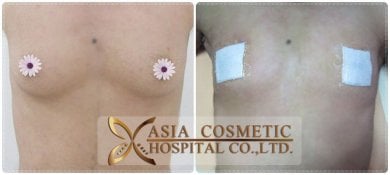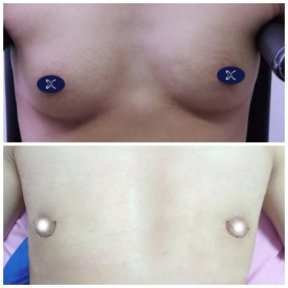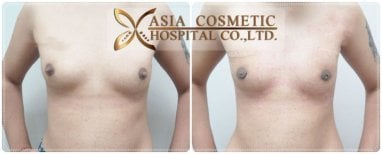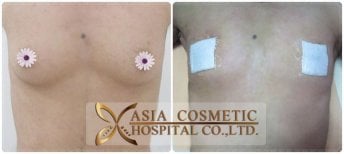- Dr. Akkrasash Vongjirad performed numerous successful mastectomies with zero post-surgery complications.
- Asia Cosmetic Hospital holds JCI accreditation and boasts a 0% rate of patient complications post-surgery.
- Included Services: Follow-up examination, follow-up visit, general anesthesia, medications, preoperative tests, post-op medications, hospitalization, transfer to the hospital.
- Stay Info: 2 days stay in the hospital, 10 days stay in the hotel (included in the price).
What is top surgery?
Top surgery is a gender-affirming procedure for transgender and non-binary individuals. It modifies chest appearance to align with one's gender identity. Transmasculine top surgery (female-to-male) involves removing breast tissue and contouring the chest. Transfeminine individuals may undergo breast augmentation. The surgery aims to alleviate gender dysphoria and enhance quality of life. Results can dramatically improve self-image and confidence.
However, it's a major medical procedure requiring careful consideration and planning. If you're looking into top surgery, Thailand offers some of the world's most experienced surgeons and high-quality facilities.
Why should I opt for top surgery?
✅ Gender-affirming surgery #1. Trans people opt for top surgery twice as often as for bottom (genital) surgery. Over 50% of transgender men and women are interested in pursuing it. Chest appearance is a key factor in gender expression. Top surgery provides immediate, visible results through a less complex and expensive procedure.
✅ Proven mental health benefits. Studies show that 86% to 100% of patients experience reduced gender dysphoria after top surgery. It enhances self-confidence, improves emotional well-being, and reduces social anxiety.
✅ Eliminates daily discomfort. For trans men, top surgery removes the need for chest binders, preventing breathing issues and musculoskeletal pain. For trans women, breast augmentation creates a natural feminine silhouette and allows to do away with padded bras and breast forms.
Who is a good candidate for top surgery?
Good candidates for top surgery typically possess the following characteristics:
✅ Adults aged 18 or older
✅ Transgender men and women, as well as non-binary individuals, experiencing persistent gender dysphoria
✅ Mentally stable with realistic expectations about surgical outcomes
✅ In good overall physical health with an acceptable Body Mass Index (BMI)
✅ Non-smokers or those willing to quit before surgery
✅ Living in their affirmed gender role for a significant period
✅ Have a supportive network of family or friends
✅ Fully understand the procedure, its effects, risks, and limitations
✅ Evaluated by a mental health professional who can provide a letter confirming the patient’s readiness for the procedure
Why choose Thailand for top surgery?
🌎 Global reputation. Thailand is a leading destination for medical tourism, attracting over 3.5 million visitors annually, with a significant number seeking gender-affirming surgeries. Known as the sex change capital of the world, Thailand stands out as the premier choice for transgender patients from across the globe.
🩺 Expertise. Thai surgeons are globally recognized for their proficiency in sex reassignment surgery (SRS), boasting decades of specialized training and experience. Since Dr. Preecha Tiewtranon performed Thailand's first transgender surgery in 1975, the country has been at the forefront of this field for nearly five decades.
🏥 World-class clinics. Hospitals like Yanhee International use the latest technologies and adhere to rigorous international standards. These institutions, along with Chulalongkorn University, drive research and training in transgender care.
💰 Affordable costs. Top surgery in Thailand costs from $2,500 to $6,000—up to 70% less than you'd pay in countries like the United States. It is a financially accessible option for those without insurance coverage or just looking for affordable options that won’t compromise quality.
🤝 Hospitality. Thai medical staff make patients feel welcome and supported, reflecting the country's accepting and open-minded culture. This welcoming atmosphere can significantly enhance your recovery experience.
🏳️⚧️ Trans-friendly culture. Thailand's visible and accepted transgender community, including prominent figures in entertainment and media, fosters an environment of understanding and respect. This cultural acceptance translates to empathetic care in medical settings.
🌴 Recovery in paradise. Imagine recovering from your top surgery in a tranquil tropical setting. Thailand offers the unique opportunity to combine your medical procedure with a rejuvenating getaway.
What top surgery techniques do doctors use in Thailand?
Thai surgeons employ a variety of top surgery techniques, choosing according to each patient's unique needs, anatomy, and skin quality.
🚹 FTM top surgery
Techniques for female-to-male top surgery (or FTM mastectomy surgery) in Thailand include:
1. Double incision with a free nipple graft
Double incision is the most common FTM top surgery method for trans men with moderate to large breasts. The surgeon makes two horizontal incisions, removes breast tissue and excess skin, contours the chest, and repositions nipples. It results in a flat chest but may lead to some scarring and potential changes in nipple sensation.
2. Periareolar technique
Ideal for smaller chest sizes (A or B cup), this FTM top surgery method involves incisions around the areola. It leaves minimal scarring and often preserves nipple sensation, though some trans men may need revisions for complete chest flatness.
3. Keyhole top surgery
This surgical technique is reserved for very small breasts with good skin elasticity. It uses a small incision along the lower areola border. Keyhole FTM surgery offers minimal scarring but has limited applicability.
4. Inverted T or T-anchor
Suitable for larger chests, this female-to-male top surgery method preserves nipple attachment and sensation. It creates a natural contour but may not achieve complete flatness.
5. Buttonhole technique
Similar to the inverted T but with less scarring, this FTM top surgery method works well for trans men with medium-sized chests. It balances tissue removal with nipple preservation.
6. Fishmouth or "Batwing" incision
This unique approach creates a distinctive and more visible scar pattern, appealing to some non-binary individuals. It offers good chest flatness and sensation preservation.
🚺 MTF top surgery
Breast augmentation for transfeminine patients involves the placement of implants to increase breast volume and improve shape.
Options include:
- Saline implants filled with sterile salt water post-insertion. They require smaller incisions and are less expensive.
- Silicone implants pre-filled with silicone gel. They offer a softer, more natural feel and better texture.
What is the cost of top surgery in Thailand?
The cost of FTM top surgery in Thailand ranges from $4,500 to $7,000, while MTF top surgery costs $2,500 to $5,000. Prices depend on the surgeon’s expertise, hospital, and surgical technique.
In comparison, FTM top surgery in the USA costs $9,000 to $15,000, while MTF top surgery costs $9,000 to $13,000. That means Thailand offers savings of up to 70% compared to the United States.
❗Keep in mind that in the US, prices often only include the surgeon’s fee. Consultations, anesthesia, hospital charges, and aftercare add thousands more to the total cost. On the other hand, Thai clinics offer all-inclusive packages.
You can compare average top surgery prices in the table below:
|
Country |
FTM Top Surgery |
MTF Top Surgery |
All-Inclusive Packages |
|
Thailand |
$4,500 – $7,000 |
$2,500 – $5,000 |
✅ Yes |
|
USA |
$9,000 – $15,000 |
$9,000 – $13,000 |
❌ No |
|
UK |
$11,000 – $15,000 |
$10,000 – $12,000 |
❌ No |
|
Australia |
$7,000 – $11,000 |
$7,500 – $10,000 |
❌ No |
|
New Zealand |
$13,000 – $16,000 |
$10,000 – $12,000 |
❌ No |
What is included in the top surgery package in Thailand?
Top surgery packages in Thailand can vary between clinics, but typically include:
- Surgeon, anesthesiologist, and operating room fees
- Hospital stay in a private room
- Essential pre-operative tests and consultations
- Anesthesia and medical supplies
- Post-operative care and medications
- Meals during hospital stay
- Follow-up appointments
- Transfers to/from hospital
- 24-hour in-room attendant for solo travelers
Where to get top surgery in Thailand?
Bangkok and Phuket are two prominent locations for top surgery in Thailand.
|
Location |
Pros |
Cons |
Top clinics |
|
• Home to Thailand’s most experienced top surgery specialists with 30+ years of expertise. • Largest selection of specialized clinics and hospitals offering a variety of FTM and MTF techniques. • Clinics provide comprehensive care, including psychological support, post-op checkups, and personalized recovery plans. • One of the world's top 10 most visited cities and a medical tourism hub. |
• A busy, urban environment may feel overwhelming. • Heavy traffic can make travel between accommodation and hospitals inconvenient. |
||
|
• Accredited clinics meeting international safety and hygiene standards. • Tranquil, resort-like recovery setting with beaches and a slower pace for post-surgical rest. • Ideal for patients seeking a stress-free healing environment away from city noise. |
• Fewer specialized top surgery surgeons, with most focusing on general plastic surgery. • 10%–15% higher costs than Bangkok due to the resort location and limited competition. |
What are the best clinics for top surgery in Thailand?
Bookimed’s research has identified the top 3 clinics in Thailand for top surgery, considering surgeon expertise, surgical techniques, patient satisfaction, and package inclusions.
Below is a comparison of the best options for gender-affirming chest surgery in Thailand:
|
Clinic |
Cost |
Included Services |
Highlights |
Patient Rating |
|
$7,700 |
• 3 meals/day by a nutritionist |
• 99% success rate for transgender surgeries. • High-tech "Clean Room" hospital standards. • Handles 2,000+ patients annually. • Famous patient: Fuschia Anne Ravena, Miss International Queen 2022. |
⭐ 4.7 |
|
|
$4,500 |
• Physical exams and tests |
• ISO & JCI-accredited hospital • Dr. Akkrasash Vongjirad, 25+ years of experience |
⭐ 4.0 |
How to find the best sex reassignment surgery specialists in Thailand?
To find the best gender surgeons in Thailand for chest reconstruction:
- Look for a board-certified plastic surgeon with extensive experience and qualifications in reconstructive surgery.
- Verify the credentials and certifications of reconstructive surgeons. Ensure they are recognized by reputable medical boards and have specialized training in gender surgery.
- Read top surgery reviews from previous patients for firsthand insights into a surgeon's expertise, patient satisfaction, and the quality of post-operative care.
- Ask for before and after photos to see examples of the surgeon’s work to assess the quality and outcomes of their work.
What are the requirements for top surgery in Thailand?
Requirements for top surgery in Thailand can vary depending on the clinic and whether it adheres to WPATH guidelines or the informed consent model. However, it's common for Thai gender surgeons to request:
- A letter from a licensed psychologist recommending surgery.
- Proof of hormone therapy for at least one year (prescription or doctor's letter).
- A series of pre-surgery tests, including a chest X-ray, EKG, complete blood count (CBC), blood sugar levels, HIV status, hepatitis B surface antigen (HBsAg), urinalysis (UA), kidney function (Bun/Cr), electrolytes, and liver function tests (LFT).
Some plastic surgery clinics may have additional or fewer requirements. It's best to check with your chosen surgeon for their specific protocols.
How should I prepare for top surgery?
🩺 Health & medication
- Stop smoking and alcohol at least 2–4 weeks before surgery to improve healing.
- Your surgeon may advise stopping certain medications, such as blood thinners, aspirin, or hormone therapy, 2–4 weeks before surgery.
- Fill any pain medications and antibiotics beforehand, so you have them ready post-op.
- Maintain a balanced diet rich in protein and vitamins.
🏡 Home preparation
- Set up your recovery space by keeping essentials within easy reach—phone, water, medications, and snacks.
- Move bathroom necessities to waist level to avoid reaching overhead.
- Precook simple, nutritious meals that are easy to reheat, as movement will be limited in the first few days.
🤝 Support system
- You won't be able to drive home after surgery, so arrange for a ride or caregiver.
- Daily tasks like cooking and cleaning will be difficult at first. Ask a friend, family member, or partner for help during the initial recovery period.
- Consider joining a peer support group or consulting a therapist to navigate the emotional aspects of surgery.
What steps does top surgery in Thailand involve?
Here is an approximate breakdown of how your visit to Thailand for top surgery will look like:
🗓️Day 1: Arrival. Upon arriving in Thailand, you'll settle into your accommodation. This day is for acclimating to the new environment and resting after travel.
🗓️Day 2: Pre-operative assessments. The day begins with an initial consultation with your doctor to discuss your surgical goals and confirm the surgical plan. If not conducted previously, pre-operative assessments and screenings will follow to ensure your fitness for surgery.
🗓️Day 3: Surgery. The surgery itself, typically performed under general anesthesia, takes 2-3 hours.
🗓️Day 4: Post-operative recovery in hospital. You’ll spend about one night in the hospital under observation to manage pain, prevent complications, and start the initial recovery.
🗓️Days 5-10: Discharge and initial recovery period. You will stay nearby for a few days after being discharged. During this time, the surgeon will monitor your recovery, remove drains if placed, and assess the surgical site. This phase includes follow-up visits to the clinic.
🗓️Day 11: Return home. Once cleared by the doctor, you can return home. Travel is usually safe at this stage, provided there are no complications.
🗓️Weeks to months after surgery. Doctors can often conduct further follow-ups virtually.
How long will the recovery from this surgical procedure take?
Recovery from both female-to-male and male-to-female top surgery generally takes about 6 weeks before patients can fully engage in physical activities.
⏳ The first 3 weeks are critical; during this period, patients need to take it easy, as they'll face the most restrictions and experience the highest levels of discomfort and swelling.
⏳ Most patients can expect to return to work within 1 to 2 weeks after the surgery, but they'll still need to manage some limitations as they heal.
⏳ Scars may take up to 12 months to heal completely.
What does post-op self-care involve?
🚫 Activity restrictions
- You'll need to sleep on your back for at least a week to avoid pressure on your chest.
- For the first 2–3 weeks, do not lift your arms above your head or lift anything heavier than a gallon of milk.
- Walking can resume after a few weeks, while sports, running, and heavy lifting should wait 6–8 weeks.
🛁 Hygiene & scar care
- Showers are not allowed until cleared by your surgeon—use sponge baths or baby wipes instead.
- Once the incisions heal, scar treatments like silicone gels or sheets can help reduce redness and improve long-term appearance.
🗓️ Long-term healing
- A healthy diet, hydration, and rest will speed up your recovery.
- Avoid smoking and alcohol.
- Listen to your body—pushing yourself too soon can increase swelling and prolong recovery.
What are the possible risks and complications of top surgery?
- Scarring. Scars may take up to 18 months to fade and could be pronounced, depending on the surgery type.
- Hematoma. Occurs in about 1-2% of cases, causing pain, swelling, and increased infection risk.
- Seroma. Fluid accumulation under the skin which might resolve on its own or require drainage.
- Infection. Rare but possible, requiring antibiotics and drainage.
- Nipple graft breakdown. Risk of tissue necrosis if nipples are repositioned, potentially needing additional surgery.
- Reduced nipple sensitivity. Nerve damage during surgery can lead to permanent changes in sensation.
How can you get the best top surgery in Thailand with Bookimed?
💚Submit a request. Fill out a form detailing your top surgery goals and preferences.
💚Consult a Bookimed expert. A dedicated manager will contact you to discuss your needs, answer questions about top surgery options in Thailand, and explain the process.
💚Select your ideal clinic. Your Bookimed manager will recommend top Thai hospitals specializing in gender-affirming chest surgeries, helping you compare options based on expertise, cost, and location.
💚Get a personalized quote. Once you've chosen a plastic surgery clinic, receive a tailored cost estimate for your top surgery procedure.
💚Plan your journey. Bookimed assists in scheduling your surgery date and coordinating your trip to Thailand, guaranteeing a well-organized experience from consultation to recovery.
Resources
- Johns Hopkins Medicine. Top Surgery (Chest Feminization or Chest Masculinization). https://www.hopkinsmedicine.org/health/treatment-tests-and-therapies/top-surgery
- Bloomberg. (2015). How Thailand Became a Global Gender-Change Destination. https://www.bloomberg.com/news/features/2015-10-26/how-thailand-became-a-global-gender-change-destination
- International Journal of Transgender Health. (2022). Standards of Care for the Health of Transgender and Gender Diverse People, Version 8. https://www.tandfonline.com/doi/pdf/10.1080/26895269.2022.2100644
- Johns Hopkins Medicine. (2021). Informed Consent Model for Gender Affirming Hormone Therapy. https://affirm.blogs.hopkinsmedicine.org/2021/03/16/informed-consent-model-for-gender-affirming-hormone-therapy/
- World Journal of Advanced Research and Reviews. (2024). Medical tourism and healthcare trends in Thailand. https://wjarr.com/sites/default/files/WJARR-2024-3188.pdf
- International Journal of Transgender Health. (2021). Preferences for and barriers to gender affirming surgeries in transgender and non-binary individuals. https://pmc.ncbi.nlm.nih.gov/articles/PMC9621289/
- Plastic and Reconstructive Surgery. (2019). Assessing Quality of Life and Patient-Reported Satisfaction with Masculinizing Top Surgery. https://journals.lww.com/plasreconsurg/abstract/2019/01000/assessing_quality_of_life_and_patient_reported.51.aspx
- JPRAS Open. (2019). Breast augmentation in male-to-female transgender patients: Technical considerations and outcomes. https://www.sciencedirect.com/science/article/pii/S2352587819300142









